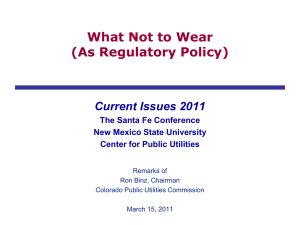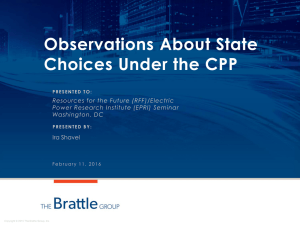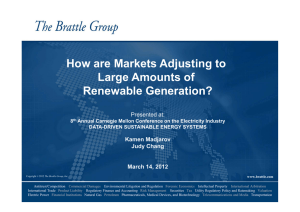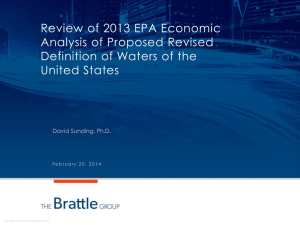Trends and Benefits of Transmission Investments: Identifying and Analyzing Value CEA Transmission Council
advertisement
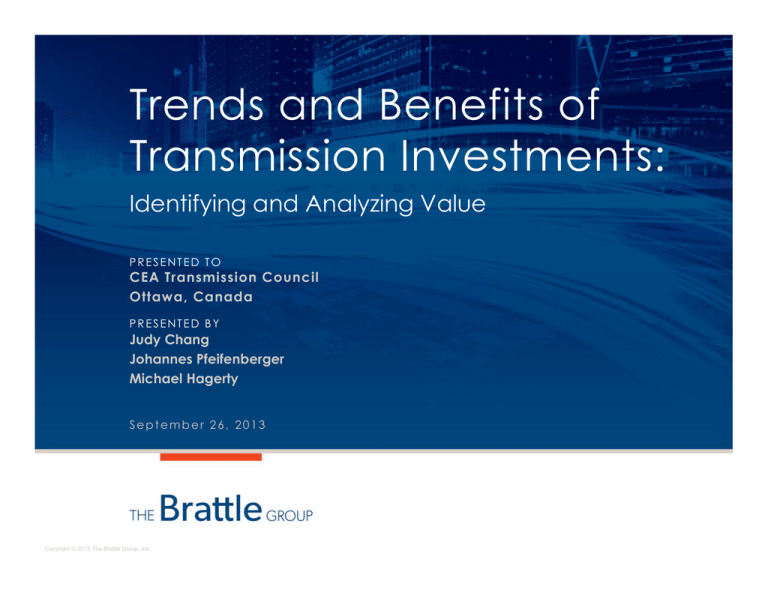
Trends and Benefits of Transmission Investments: Identifying and Analyzing Value PRESENTED TO CEA Transmission Council Ottawa, Canada PRESENTED BY Judy Chang Johannes Pfeifenberger Michael Hagerty September 26, 2013 Copyright © 2013 The Brattle Group, Inc. Content A. Transmission Investment Trends B. Importance of Considering all Benefits C. Evolving RTO and non‐RTO Experience D. Checklist of Transmission Benefits E. Proposed Framework for Incorporating Benefits F. Comparing Uncertain Benefits and Costs G. Interregional Planning Appendix 1 | brattle.com A. Historical and Future Transmission Additions ▀ ▀ ▀ 3,000 to 7,000 circuit‐miles per year reported for 2013‐16 in U.S.; Equivalent to $7‐16 billion (averaging $12b) per year nationwide Up from 1985‐2005, but still below levels of 1960s to early 1980s Significant replacement/upgrade needs over next decade(s) 10,000 [1]: EEI (>132kV) [2]: NERC (>200kV) [3]: Ventyx (>200kV) 8,000 Projected Transmission Additions from NERC under Form EIA-411 (>200kV) Projected Transmission Additions from NERC under Form EIA-411 (all) 4,000 Period of Major Base Load Generator Additions and NERC-coordinated Construction of Regional Interties between Major Utilities to Improve Reliability in Response to Blackouts 2,000 2015 2010 2005 2000 1995 1990 1985 1980 1975 1970 1965 0 1960 Circuit Miles 6,000 2 | brattle.com A. Increasing Transmission Investments ▀ ▀ Annual Transmission Investment ($Billions) $14B Increasing annual investment by FERC‐jurisdictional transmission owners in U.S. (representing approximately 70% of U.S. total) We project $120‐160 billion of investment per decade through 2030 Northeast $12B $10B South $8B $6B FERC-defined Subregions Midwest Northwest $4B Southwest $2B $0B 1995 1996 1997 1998 1999 2000 2001 2002 2003 2004 2005 2006 2007 2008 2009 2010 2011 2012 Sources and Notes: The Brattle Group's analysis of FERC Form 1 data compiled in Ventyx's Velocity Suite. Based on EIA data available through 2003, FERC-jurisdictional transmission owners estimated to account for 80% of transmission assets in the Eastern Interconnection, and 60% in WECC and ERCOT. Facilities >300kV estimated to account for 60-80% of shown investments. 3 | brattle.com A. Increasing Transmission Needs – Implications ▀ Significant increases in transmission investment to : − Serve growing loads (even if growing more slowly) − Interconnect new conventional generation resources and facilitate generation plant retirements − Decrease congestion and increase market efficiency − Replace and upgrade aging transmission facilities − Support public policy goals (e.g., integration of renewable generation) ▀ Benefits can be captured with projects achieving multiple objectives: − Modify reliability projects to capture other benefits − Pursuing projects that provide highest long‐term value (even if not lowest transmission project costs) − Utilizing available rights‐of‐way more efficiently in long run − Creating options for improved future planning, operational, and economic efficiencies ▀ The industry needs an integrated framework to evaluate transmission investments in context of these multiple needs, benefits, and options 4 | brattle.com B. Importance of Considering All Benefits ▀ ▀ ▀ Not all proposed transmission projects can (or should) be justified economically Transmission projects can provide a wide range of benefits—economic, public, and reliability—to a range of market participants and regions Narrow or conservative evaluation of transmission benefits risks rejection of valuable projects − Transmission benefits in large part are a reduction in system‐wide costs − Not considering the full economic benefits of transmission investments means not considering all costs and the potentially very‐high‐cost outcomes that market participants would face without these investments ▀ Production cost simulations have become a standard tool to assess “economic benefits” of transmission, but only considers short‐term dispatch‐cost savings under very simplified system conditions (e.g., no transmission outages) − Simplified simulations reflect incomplete production cost savings, thus only a smaller portion of the overall economy‐wide benefits 5 | brattle.com C. Evolving RTO and non-RTO Experience ▀ Planners and regulators increasingly recognize importance of considering the wide range of transmission benefits ▀ In recent years, some RTOs—in particular the SPP, MISO and CAISO)— gradually expanded transmission planning beyond addressing reliability and load serving concerns to include economic and public‐ policy drivers. ▀ Other RTOs and most non‐RTO regions still rely primarily on the traditional application of production cost simulations estimate economic value of transmission ▀ Despite the differences among regions in how they consider transmission benefits in planning, the same set of potential transmission benefits applies in all of them 6 | brattle.com C. Benefits in RTO Regional Planning RTO Planning Process Estimated Benefits Other Benefits Considered (without necessarily estimating their value) Facilitation of the retirement of aging power plants Encouraging fuel diversity Improved reserve sharing Increased voltage support Production cost savings and reduced energy prices from both a societal and customer perspective Mitigation of market power Insurance value for high‐impact low‐probability events Capacity benefits due to reduced generation investment costs Operational benefits (RMR) Reduced transmission losses Emissions benefits Production cost savings Enabling future markets Reduced transmission losses Storm hardening Wind revenue impacts Natural gas market benefits Improving operating practices/maintenance schedules Reliability benefits Lowering reliability margins Economic stimulus benefits of transmission and wind generation construction Improving dynamic performance and grid stability during extreme events Societal economic benefits CAISO TEAM (as applied to PVD2) SPP ITP Analysis Additional benefits recommended by SPP’s Metrics Task Force Reduced energy losses, Mitigation of weather uncertainty Reduced transmission outage costs Reduced cost of extreme events Mitigation of renewable generation uncertainty Value of reduced planning reserve margins or loss of load probability Reduced cycling of baseload plants Increased ability to hedge congestion costs Increased competition and liquidity Increased wheeling through and out revenues Value of meeting public policy goals 7 | brattle.com C. Benefits in RTO Regional Planning RTO Planning Process Estimated Benefits Other Benefits Considered (without necessarily estimating their value) MISO MVP Analysis NYISO CARIS PJM RTEP ERCOT LTS ISO‐NE RSP Production cost savings Enhanced generation policy flexibility Reduced operating reserves Increased system robustness Reduced planning reserves Decreased natural gas price risk Reduced transmission losses Decreased CO2 emissions output Reduced renewable generation investment costs Decreased wind generation volatility Reduced future transmission investment costs Increased local investment and job creation Emissions costs Load and generator payments Installed capacity costs Transmission Congestion Contract value Public policy benefits Public policy benefits Public policy benefits Reliability benefits Production cost savings Reliability benefits Production cost savings Reliability benefits Production cost savings Avoided transmission project costs Reliability benefits Net reduction in total production costs 8 | brattle.com C. Benefits in Non-RTO Regional Planning Non‐RTO Planning Organization Benefits Considered in Regional Planning WECC Avoided local transmission project costs Production cost savings Reduced generation capital costs ColumbiaGrid Avoided local transmission project costs NTTG Avoided local transmission project costs Reduced energy losses Reduced reserve costs WestConnect Avoided local transmission project costs Production cost savings Reserve sharing benefits SERTP Avoided local transmission project costs NCTPC Avoided local transmission project costs Florida Sponsors Avoided local transmission project costs 9 | brattle.com D. “Checklist” of Economic Transmission Benefits ▀ Compiled a “checklist of economic benefits” from a detailed review of industry practices and our own experience − Can be used to help identify the potential benefits of transmission investments − Recommend policy makers and planners use this checklist to document, evaluate, and communicate a comprehensive “business case” for transmission projects. ▀ How to estimate the monetary value of benefits in checklist? − Some benefits should be measured routinely with existing tools and metrics (such as “Adjusted Production Cost” savings) − Other potentially‐significant, but difficult‐to‐estimate benefits should be analyzed by calculating their likely range and magnitude − Omitting consideration of such difficult‐to‐estimate benefits inherently assigns a zero value and thereby results in a systematic understatement of total project benefits 10 | brattle.com D. “Checklist” of Economic Transmission Benefits Benefit Category Transmission Benefit (see Appendix for descriptions and detail) Traditional Production Cost Savings Production cost savings as currently a. Impact of generation outages and A/S unit designations b. Reduced transmission energy losses c. Reduced congestion due to transmission outages d. Mitigation of extreme events and system contingencies e. Mitigation of weather and load uncertainty f. Reduced cost due to imperfect foresight of real‐time system conditions g. Reduced cost of cycling power plants h. Reduced amounts and costs of operating reserves and other ancillary services i. Mitigation of reliability‐must‐run (RMR) conditions j. More realistic “Day 1” market representation a. Avoided/deferred reliability projects b. Reduced loss of load probability or c. reduced planning reserve margin a. Capacity cost benefits from reduced peak energy losses b. Deferred generation capacity investments d. Access to lower‐cost generation resources a. Increased competition b. Increased market liquidity a. Reduced emissions of air pollutants b. Improved utilization of transmission corridors Reduced cost of meeting public policy goals Increased employment and economic activity; Increased tax revenues Examples: storm hardening, fuel diversity, flexibility, reducing the cost of future transmission needs, wheeling revenues, HVDC operational benefits 1. Additional Production Cost Savings 2. Reliability and Resource Adequacy Benefits 3. Generation Capacity Cost Savings 4. Market Benefits 5. Environmental Benefits 6. Public Policy Benefits 7. Employment and Economic Stimulus Benefits 8. Other Project‐Specific Benefits 11 | brattle.com Example: Range of Project Benefits vs. Costs Total electricity market benefits of SCE’s DPV2 project in CAISO exceeded project costs by more than 50% Expected Annual Benefits of DPV2 ($ millions) 125 2 1 119 Emissions Benefit Total Annual 12 100 20 Levelized Cost: 71 75 28 50 25 56 Source: Economic Evaluation of the Palo Verde‐Devers Line No. 2 (PVD2), CAISO, February 24, 2005. 0 Production Cost Benefits (Net of FTRs) Competitiveness Benefits Operational Benefits (RMR, MLCC) Generation Investment Cost Savings Reduced Losses 12 | brattle.com Example: Range of Project Benefits vs. Costs ATC’s Paddock‐Rockdale study: Significant net benefits (production cost savings alone exceeded costs in some scenarios) NPV of Expected Benefits Under High Environmental Scenario ($ Million) 250 220 15 200 28 NPV Cost: 137 49 150 6 42 100 50 Note: adjustment for FTR and congestion benefits was negative in 3 out of 7 scenarios (e.g., a negative $117m offset to $379m in production cost savings) 80 Source: American Transmission Company, Planning Analysis of the Paddock‐Rockdale Project, April 2007. 0 Production Cost Benefits Loss Benefits incl. Refunds FTR and Competitiveness Insurance Capacity Total Benefits Congestion Benefits Benefit During Savings From Benefits (for limited WI System Failure Reduced Market‐Based Events Losses Pricing) 13 | brattle.com E. Proposed Framework for Incorporating Benefits 1. System planners and stakeholders to identify potentially valuable transmission projects and develop a comprehensive list of likely benefits 2. Perform unbiased evaluation of proposed projects to estimate the value of as many of the identified benefits as practical without regard to how the benefits would be distributed 3. Determine whether the projects would be beneficial overall by comparing estimated economy‐wide (often referred to as “societal”) benefits with estimates of total project costs 4. Address cost allocation last—and for portfolio of beneficial projects—to reduce incentives to minimize benefits and avoid premature rejection of valuable projects 14 | brattle.com F. Comparing Uncertain Benefits and Costs ▀ Long life of assets requires comparison of long‐term benefits and costs: − Either on a present value or levelized annual basis − Over a time period, such as 40 or 50 years, that approaches the useful life of the physical assets ▀ How benefits and costs accrue over time and across future scenarios will help optimize the timing of investments ▀ Near‐ and long‐term uncertainties need to be addressed to develop robust plans and least‐regret projects: − Long‐term uncertainties (industry structure, new technologies, fundamental policy changes, and shifts in fuel market fundamentals) can be addressed through scenario‐based analyses − Near‐term uncertainties within long‐term scenarios (uncertainties in loads, fuel prices, transmission and generation outages) should be evaluated through sensitivity or “probabilistic” analyses 15 | brattle.com G. Interregional Planning ▀ Interregional planning and cost allocation is especially challenging ▀ Neighboring regions tend to evaluate interregional projects based only on the subset of benefits that are common to the planning processes of both regions − Results in the consideration of a narrower set of benefits in interregional projects than are considered for region‐internal projects − Results in “de‐militarized zones” between regions ▀ To avoid this “least common denominator” outcome, we recommend that each region, at a minimum, evaluate interregional projects based on all benefits that they consider for their regional projects ▀ Without recognizing all potential benefits, interregional planning will not find many projects that would benefit two or more regions 16 | brattle.com Appendix Additional Reading Chang, Pfeifenberger, Hagerty, "The Benefits of Electric Transmission: Identifying and Analyzing the Value of Investments,“ prepared for WIRES, July 2013. Pfeifenberger "Independent Transmission Companies: Business Models, Opportunities, and Challenges," American Antitrust Institute's 13th Annual Energy Roundtable, April 23, 2013. Pfeifenberger, Chang, Hou "Bridging the Seams: Interregional planning under FERC Order 1000," Public Utilities Fortnightly, November 2012. Pfeifenberger "Transmission Investment Trends and Planning Challenges," EEI Transmission and Wholesale Markets School, August 8, 2012 Pfeifenberger and Hou, "Seams Cost Allocation: A Flexible Framework to Support Interregional Transmission Planning,“ April 2012. Pfeifenberger and Hou, Transmission’s True Value: Adding up the Benefits of Infrastructure Investments, Public Utilities Fortnightly, February 2012. Pfeifenberger and Hou, Employment and Economic Benefits of Transmission Infrastructure Investment in the U.S. and Canada, on behalf of WIRES, May 2011. Pfeifenberger, Easier Said Than Done: The Continuing Saga of Transmission Cost Allocation, Harvard Electricity Policy Group meeting, Los Angeles, February 24, 2011. Pfeifenberger and Newell, Direct testimony on behalf of The AWC Companies re: the Public Policy, Reliability, Congestion Relief, and Economic Benefits of the Atlantic Wind Connection Project, filed December 20, 2010 in FERC Docket No. EL11-13. Pfeifenberger, Chang, Hou, Madjarov, “Job and Economic Benefits of Transmission and Wind Generation Investments in the SPP Region,” The Brattle Group, Inc., March 2010. “Comments of Peter Fox-Penner, Johannes Pfeifenberger, and Delphine Hou,” in response to FERC’s Notice of Request for Comments on Transmission Planning and Cost Allocation (Docket AD09-8). Pfeifenberger, "Assessing the Benefits of Transmission Investments," presented at the Working Group for Investment in Reliable and Economic Electric Systems (WIRES) meeting, Washington, DC, February 14, 2008. Pfeifenberger, Direct Testimony on behalf of American Transmission Company re: Transmission Cost-Benefit Analysis Before the Public Service Commission of Wisconsin, Docket 137-CE-149, January 17, 2008. Pfeifenberger, Testimony on behalf of Southern California Edison Company re: economic impacts of the proposed DeversPalo Verde No. 2 transmission line, before the Arizona Power Plant and Transmission Line Siting Committee, Docket No. L-00000A-06-0295-00130, Case No. 130, September and October, 2006. 18 | brattle.com What is Not Addressed in our WIRES Report? ▀ Permitting and siting of new transmission facilities ▀ Processes and options for cost allocation ▀ Differences between regulated and merchant transmission ▀ Differences between the transmission planning and utility IRP processes ▀ Detailed discussion of iterative transmission planning process itself, including evaluation of transmission and non‐transmission alternatives ▀ Development of decision‐analysis tools or frameworks that may be able to streamline the planning process ▀ Institutional and organizational barriers to creating a credible, unbiased, and comprehensive planning process ▀ Implications of setting different allowed rates of return on transmission investments and regulatory incentives for such investments ▀ Broader political economy associated with building transmission, cost allocation, permitting, and regulation 19 | brattle.com 1. Additional Production Cost Savings Transmission Benefit 1a. Reduced impact of generation outages and A/S designations 1b. Reduced transmission energy losses Benefit Description Consideration of generation outages (and A/S unit designations) will increase impact Reduced energy losses incurred in transmittal of power from generation to loads reduces production costs Approach to Estimating Benefit Consider both planning and (at least one draw of) forced outages in market simulations. Set aside resources to provide A/S in non‐optimized markets. Either (1) simulate losses in production cost models; (2) estimate changes in losses with power flow models for range of hours; or (3) estimate how cost of supplying losses will likely change with marginal loss charges 1c. Reduced congestion Reduced production costs during Introduce data set of normalized outage schedule (not due to transmission transmission outages that including extreme events) into simulations or reduce significantly increase transmission limits of constraints that make constraints bind more outages congestion frequently Reduced production costs during Calculate the probability‐weighed production cost 1d. Mitigation of extreme events and extreme events, such as unusual benefits through production cost simulation for a set of weather conditions, fuel shortages, extreme historical market conditions system contingencies or multiple outages. 1e. Mitigation of Reduced production costs during Use SPP suggested modeling of 90/10 and 10/90 load weather and load higher than normal load conditions conditions as well as scenarios reflecting common or significant shifts in regional uncertainty regional weather patterns weather patterns 1f. Reduced costs due to Reduced production costs during Simulate one set of anticipated load and generation imperfect foresight of deviations from forecasted load conditions for commitment (e.g., day ahead) and conditions, intermittent resource another set of load and generation conditions during real‐time conditions generation, or plant outages real‐time based on historical data Further develop and test production cost simulation to 1g. Reduced cost of Reduced production costs due to cycling power plants reduction in costly cycling of power fully quantify this potential benefit ; include long‐term plants impact on maintenance costs Examples Outages considered in most RTO’s CAISO (PVD2) ATC Paddock‐ Rockdale SPP (RCAR) SPP (RCAR) RITELine CAISO (PVD2) ATC Paddock‐ Rockdale SPP (RCAR) WECC study 20 | brattle.com 1. Additional Production Cost Savings Transmission Benefit Benefit Description Approach to Estimating Benefit 1h. Reduced amounts and costs of ancillary services 1i. Mitigation RMR conditions Reduced production costs for Analyze quantity and type of ancillary services needed required level of operating reserves with and without the contemplated transmission investments Reduced dispatch of high‐cost RMR Changes in RMR determined with external model used generators as input to production cost simulations 1j. More realistic “Day 1” market representation Transmission expansion provide additional benefits in markets where congestion is managed less efficiently Examples NTTG WestConnect MISO MVP ITC‐Entergy CAISO (PVD2) Apply “hurdle rates” between transmission systems and DOE and MISO balancing areas (standard approach) plus derate Day‐2 market transfer capability for underutilized system during TLR benefit studies events (e.g., by 5‐16%) 21 | brattle.com 2+3. Resource Adequacy and Generation Capacity Cost Savings Transmission Benefit Benefit Description Approach to Estimating Benefit Examples 2a. Avoided or deferred reliability projects Reduced costs on avoided or delayed Calculate present value of difference in revenue All RTOs and non‐RTOs transmission lines otherwise required requirements of future reliability projects with ITC‐Entergy analysis and without transmission line, including trajectory MISO MVP, ERCOT to meet future reliability standards of when lines are likely to be installed 2b. Reduced loss of load probability Reduced frequency of loss of load events (if planning reserve margin is not changed despite lower LOLEs) Or: Calculate value of reliability benefit by multiplying SPP (RCAR) the estimated reduction in Expected Unserved Energy (MWh) by the customer‐weighted average Value of Lost Load ($/MWh) 2c. Reduced planning Reduced investment in capacity to meet resource adequacy reserve margin requirements (if planning reserve margin is reduced) Calculate present value of difference in estimated MISO MVP net cost of new entry (Net CONE) with and SPP (RCAR) without transmission line due to reduced resource adequacy requirements 3a. Capacity cost benefits from reduced peak energy losses 3b. Deferred generation capacity investments 3c. Access to lower‐ cost generation Reduced energy losses during peak load reduces generation capacity investment needs Calculate present value of difference in estimated net cost of new entry (Net CONE) with and without transmission line due to capacity savings from reduced energy losses Reduced costs of generation capacity Calculate present value of capacity cost savings due to deferred generation investments based on investments through expanded import capability into resource‐ Net CONE or capacity market price data constrained areas Reduced total cost of generation due Calculate reduction in total costs from changes in to ability to locate units in a more the location of generation attributed to access economically efficient location provided by new transmission line ATC Paddock‐Rockdale MISO MVP SPP ITC‐Entergy ITC‐Entergy CAISO (PVD2) MISO ATC Paddock‐Rockdale 22 | brattle.com 4+5+6+7. Market, Environmental, Public Policy, and Economic Stimulus Benefits Transmission Benefit 4. Market Benefits 4a. Increased competition 4b. Increased market liquidity 5. Environmental Benefits 6. Public Policy Benefits 5a. Reduced emissions of air pollutants 5b. Improved utilization of transmission corridors Reduced cost of meeting public policy goals 7. Employment and Increased Economic Stimulus employment, economic Benefits activity, and tax revenues Benefit Description Approach to Estimating Benefit Reduced bid prices in wholesale Calculate reduction in bids due to market due to increased increased competition by modeling competition amongst generators supplier bid behavior based on market structure and prevalence of “pivotal suppliers” Reduced transaction costs and Estimate differences in bid‐ask spreads for more and less liquid markets; estimate price uncertainty impact on transmission upgrades on market liquidity Reduced output from generation Additional calculations to determine net benefit emission reductions not already resources with high emissions reflected in production cost savings Preserve option to build Compare cost and benefits of upsizing transmission upgrade on an transmission project (e.g., single circuit existing corridor or reduce the line on double‐circuit towers; 765kV line cost of foreclosing that option operated at 345kV) Reduced cost of meeting policy Calculate avoided cost of most cost effective solution to provide compliance goals, such as RPS to policy goal Increased full‐time equivalent (FTE) years of employment and economic activity related to new transmission line A separate analysis required for quantification of employment and economic activity benefits that are not additive to other benefits. Examples ATC Paddock‐Rockdale CAISO (PVD2, Path 26 Upgrade) SCE (PVD2) NYISO CAISO ERCOT CREZ ISO‐NE, CAISO MISO MVP SPP (RCAR) SPP MISO MVP 23 | brattle.com 8. Other Project-Specific Benefits Transmission Benefit Benefit Description Approach to Estimating Benefit Examples 8a.Storm hardening Increased storm resilience of existing grid transmission system Estimate VOLL of reduced storm‐related outages. Or ITC‐Entergy estimate acceptable avoided costs of upgrades to existing system 8b. Increased load serving capability Avoided cost of incremental future upgrades; economic development benefit of infrastructure that can Value can be identified through studies evaluating a range of futures that would allow for evaluation of “no regrets” projects that are valuable on a stand‐ alone basis and can be used as an element of a larger potential regional transmission build out ITC‐Entergy 8c.Synergies with future transmission projects Increase future load‐serving capability ahead of specific load interconnection requests Provide option for a lower‐cost upgrade of other transmission lines than would otherwise be possible, as well as additional options for future transmission expansions 8d. Increased fuel diversity and resource planning flexibility Interconnecting areas with different resource mixes or allow for resource planning flexibility 8e. Increased wheeling revenues Estimate based on transmission service requests or interchanges between areas as estimated in market simulations SPP (RCAR) ITC‐Entergy 8f. Increased transmission rights and customer congestion‐hedging value Increased wheeling revenues result from transmission lines increasing export capabilities. Additional physical transmission rights that allow for increased hedging of congestion charges. 8g. Operational benefits of HVDC transmission Enhanced reliability and reduced system operations costs CAISO (Tehachapi) MISO MVP ATC Paddock‐ Rockdale PJM PATH, AWC analyses 24 | brattle.com About the Authors Judy Chang Hannes Pfeifenberger Mike Hagerty Judy Chang and Johannes Pfeifenberger are Principals, and Michael Hagerty is an Associate at The Brattle Group, an economic consulting firm with offices in Cambridge, Massachusetts; Washington, DC; San Francisco; London; Madrid; and Rome. They can be contacted at www.brattle.com. This presentation is based on the report with the same title posted here: http://wiresgroup.com/docs/WIRES%20Brattle%20Rpt%20Benefits%20Transmission%20July%202013.pdf 25 | brattle.com About The Brattle Group The Brattle Group provides consulting and expert testimony in economics, finance, and regulation to corporations, law firms, and governmental agencies around the world. We combine in‐depth industry experience, rigorous analyses, and principled techniques to help clients answer complex economic and financial questions in litigation and regulation, develop strategies for changing markets, and make critical business decisions. Our services to the electric power industry include: • • • • • • • • • • Climate Change Policy and Planning Cost of Capital & Regulatory Finance Demand Forecasting & Weather Normalization Demand Response & Energy Efficiency Electricity Market Modeling Energy Asset Valuation & Risk Management Energy Contract Litigation Environmental Compliance Fuel & Power Procurement Incentive Regulation • • • • • • • • • • Market Design & Competitive Analysis Mergers & Acquisitions Rate Design, Cost Allocation, & Rate Structure Regulatory Compliance & Enforcement Regulatory Strategy & Litigation Support Renewables Resource Planning Retail Access & Restructuring Strategic Planning Transmission 26 | brattle.com About the Brattle Group – Our Offices NORTH AMERICA Cambridge New York San Francisco Washington, DC +1.617.864.7900 +1.646.571.2200 +1.415.217.1000 +1.202.955.5050 London Madrid Rome +44.20.7406.7900 +34.91.418.69.70 +39.06.48.888.10 EUROPE 27 | brattle.com
